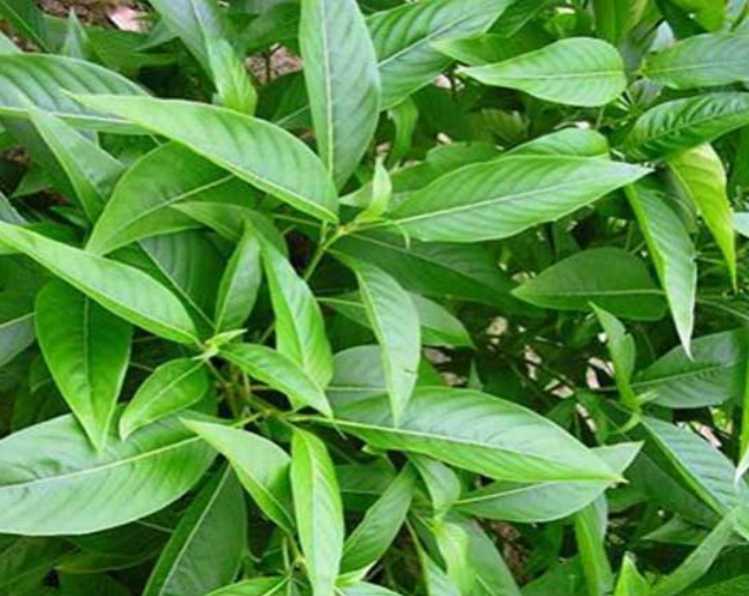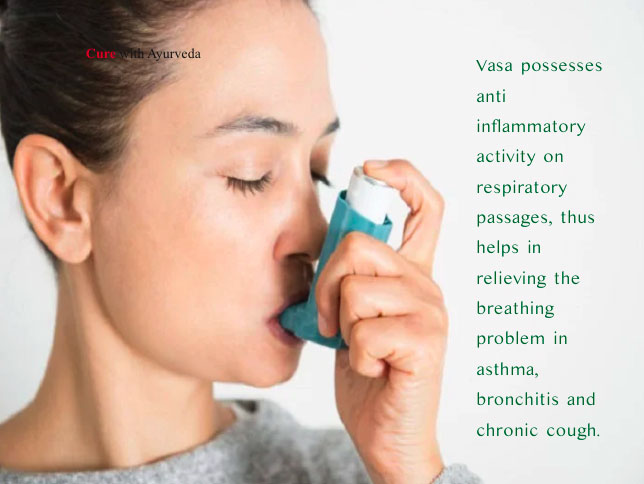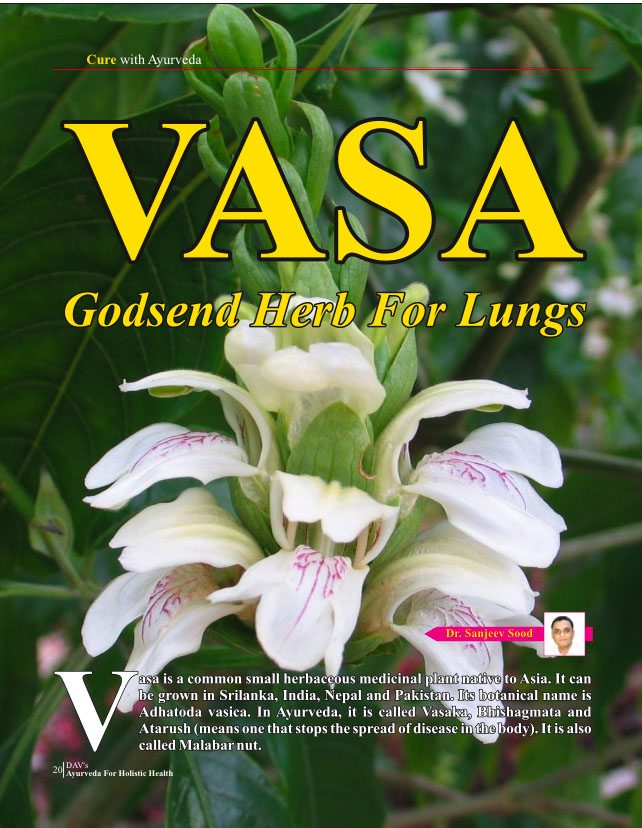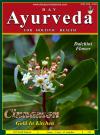Vasa is a common small herbaceous medicinal plant native to Asia. It can be grown in Srilanka, India, Nepal and Pakistan. Its botanical name is Adhatoda vasica. In Ayurveda, it is called Vasaka, Bhishagmata and Atarush (means one that stops the spread of disease in the body). It is also called Malabar nut. Various bio-active chemicals in Vasa leaves make it the versatile herb. In Ayurveda, it is mentioned as antiasthmatic, autitussive, antidiabetic & haemostatic. Vasa bears potent expectorant action which helps loosen phlegm deposits in the airway. The extract of Vasa leaves shows excellent sucrase inhibitory actuvity. Thus, it can be explored as a natural anti-diabetic.
In Ayurveda, Vasa is mentioned as antiasthmatic, autitussive, antipyretic, antidiabetic, beneficial in skin diseases, controls bleeding and acts as a tonic.
It grows up to a height of 2 meters. It is propagated by tender stem cuttings. It bears broad, shiny leaves which are bitter in taste. Flowers are white in colour and have large attractive petals. Fruit is a small capsule with 4 seeds. The wood is soft. The leaves of Vasa contain significant amount of phenols, flavonoids and alkaloids. Prominent alkaloid is quinazoline known as vasicine. The presence of numerous bio-active chemicals in the leaves and other parts make the plant a prominent medicinal herb. The therapeutic uses of Vasa in treating various human ailments has been well documented. The alkaloid vasicine possesses the property of treating ailments of respiratory tract where it is used as an expectorant and bronchodialator. Vasicine has recently been modified to form bromhexine derivative, a mucolytic agent. Vasicine has been compared to theophyllin. Alkaloids have also been reported to show temperate hypotensive activity.

Ayurvedic Energetics
Taste- Bitter, astringent
Quality-Light, dry
Potency- Cold
Post-digestive effect-Pungent
Action- Balances Kapha and Pitta
Parts used- Leaf, root, flower, whole plant.
Health Benefits of Vasa

1. Respiratory Ailments
Ayurvedic text Charak Samhita has classified Vasa under mucolytic and expectorant drugs. Vasa is considered useful in treating bronchitis, asthma and other respiratory disorders. It bears potent expectorant action which helps loosen phlegm deposits in the airway. It induces bronchodilation and relaxation of the bronchial muscles, thus relieves the breathing problems. For relief of asthma, people in rural areas inhale the smoke of dried vasa leaves. Bromhexine and Ambroxol derivatives of vasicine from vasa have growth inhibitory effect on tuberculosis bacteria. It possesses anti inflammatory activity on respiratory passages. It relieves cough.
2. Sinusitis
Sinusitis is an irritating condition where there is inflammation of sinus mucosa and release of excess mucus which is not drained properly and obstructs upper airway. Vasa works by diluting this mucus and opens the passages of sinuses thereby helps in relieving nasal stuffiness and post nasal drip.
3. Bleeding disorders
Vasa is used to control bleeding in piles, peptic ulcers, dysfunctional uterine conditions, fissures, epistaxis and bleeding gums due to the presence of phytochemicals like tannins, saponins and alkaloids. The leaf extract is mostly used to cure bleeding disorders. There has been a report of platelet increasing activity with vasicine.
4. Diabetes
The extract of Vasa leaves shows excellent sucrase inhibitory activity. Thus, it can be explored as a natural anti-diabetic. The ethanolic extracts from the leaves show hypoglycemic activity.
5. An Anti-oxidant
The extract of Vasa possesses high level of polyphenolic compounds which perform anti-oxidant activity and bear free radical scavenging effects.
6. Anti Viral
Scientific studies reveal strong anti influenza viral activity of Vasa. It may be used as a viral prophylaxis.
7. As a Diuretic
The leaves have diuretic action due to anti-inflammatory activity of its alkaloids. For this, the leaves are boiled and their decoction is poured on the bladder region.
8. As an Antacid
Vasa helps improve the symptoms of indigestion and heart burn seen in cases of gastritis or gastric ulcers.
9. An Antidiarrheal
Vasa leaves powder acts as an anti spasmodic and anti inflammatory and anti microbial. Thus it works in curing diarrhea and dysentery.
10. Anti inflammatory
Vasa leaves have anti inflammatory effect on swollen and painful joints
Side effects
It acts as uterine stimulant and functions as abortifacient. So it must not be used in pregnancy.
Therapeutic Uses of Vasa
1. In gastric ulcers, Vasa is taken with mulethi and shatavari.
2. In bleeding disorders, Vasa is used with draksha, haritki, honey and jaggery.
3. In gout, it is used with giloye.
4. In upper respiratory infections, it is used with ginger, pippali, honey and jaggery.
5. In arthritis, a poultice of Vasa leaves is applied on swollen joints.
6. In bronchial asthma, smoke of dry Vasa leaves is used to relieve the attack.
7. Topical application of fresh Vasa leaves paste on skin helps manage boils and ulcers by reducing the pain and inflammation in the affected area.
Dose
- Leave powder 3-5 gm two times a day
- Leaf decoction 100 ml two times a day
- Root powder 1 gm two times a day
- Leaf juice 5-10 ml two times a day
Ayurvedic Formulations of Vasa
• Vasa Ghan
• Vasa Ghrit
• Vasa Avleha
• Vasa Arishta
• Vasaka Asava
• Vasa Churna
The therapeutic uses of Vasa are well documented. All its parts carry important medicinal properties. It is regarded as a universal panacea in Ayurvedic medicine and finds its position as a versatile herb.
Dr. Sanjeev Sood
Principal,
Dayanand Ayurvedic College, Jalandhar.
Mob.: 9814004142, drsanjeevsood@gmail.com







 Dec 2024
Dec 2024
 May 2024
May 2024
 September 2022
September 2022
 April 2022
April 2022
 October 2020
October 2020
 Jan 2020
Jan 2020
 June 2019
June 2019
 January-February 2019
January-February 2019
 Augest-September
Augest-September
 April 2018
April 2018
 November 2017
November 2017
 June 2017
June 2017
 November 2016
November 2016
 September 2015
September 2015
 March 2015
March 2015
 July 2014
July 2014
 January 2014
January 2014
 July2013
July2013
 March 2013
March 2013
 May 2012
May 2012
 May 2011
May 2011
 Sep 2010
Sep 2010
 Jun 2010
Jun 2010
 Feb 2010
Feb 2010
 December 2009
December 2009
 August 2009
August 2009
 June 2009
June 2009
 Feb 2009
Feb 2009
 December 2008
December 2008
 October 2008
October 2008
 March 2008
March 2008
 July 2008
July 2008
 May 2008
May 2008